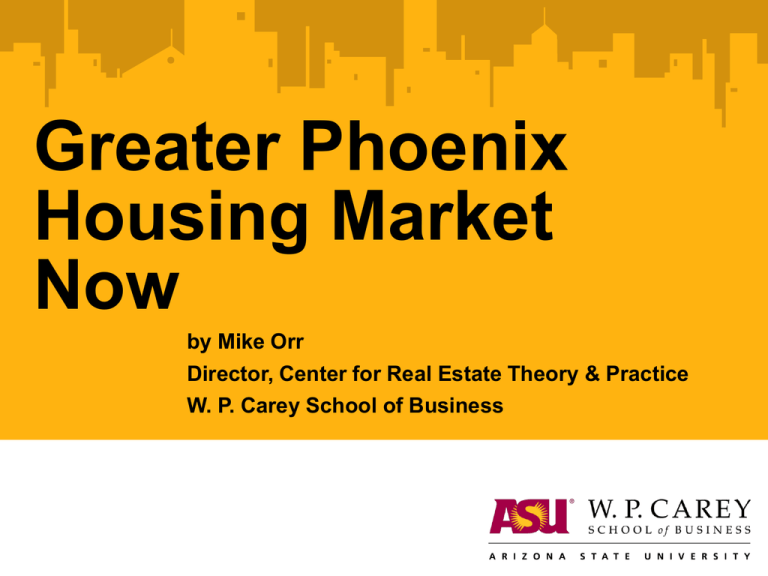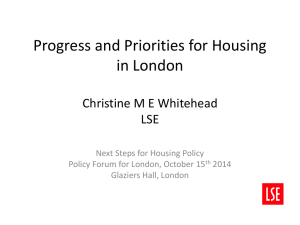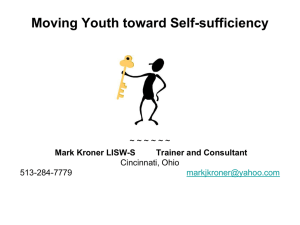Mike Orr`s slides – January 17, 2015
advertisement

Greater Phoenix Housing Market Now by Mike Orr Director, Center for Real Estate Theory & Practice W. P. Carey School of Business The Market Cycle Euphoria Exhilaration Enthusiasm Unease Denial Pessimism Optimism Panic Capitulation Despair Enthusiasm Optimism Relief Hope Skepticism The Market Cycle 2005 Euphoria Exhilaration Enthusiasm 2007 Unease Denial Pessimism Optimism 2003 Enthusiasm Panic Capitulation 2008 Despair Optimism Relief Hope 2012 Skepticism 2010 2015 $134 Another +44% to reach the peak! Nov 2004 May 2008 Only Florida and Nevada are further from their peak Another +44% to reach the peak! Nov 2004 May 2008 what and where • technology Most home prices are flat or and – Smart Homes emerge – technological disruption consumerpace demand for connected places important keeping with 1.5% inflation. – Technology pushing change in space use – E-commerce and crowdfunding being viewed as an Some segments adaptation challenge are falling or • “Omnichannel distribution" and “e-tailers” to open brickrising, but not by much. and-mortar stores – changes where and how we do things what and for where • Demand WEAK homes to buy • technology • – Smart Homes emerge – technological disruption and Demand STRONG homes consumer demand for connectedfor places important to –rent Technology pushing change in space use – E-commerce and crowdfunding being viewed as an adaptation challenge • Demand remains STRONG for • “Omnichannel distribution" and “e-tailers” to open brickand-mortar stores – changes where and how we do things very high-end luxury homes Why is Demand Weak? – Investor purchases dropped 41% in 2014 from 2013. – Owner/occupier purchases rose 0.3%. – Millennials are not buying homes like their parents did. • Far more living with parents, sharing or renting – 1 in 4 former owners are in “The Penalty Box.” • 367,000 owners lost homes to foreclosure/short sale – Large lenders are still very risk-averse. • Avg. FICO for DENIED Conventional Purchase Loan = 722 • Avg. FICO for CLOSED Loan = 754 – Income and wealth disparity is increasing. – Very slow income growth (0.9% for Phoenix 20112013) Millennial Impact on Housing Market – – – – – – – – – Starting families later than earlier generations Lower birth rates Many still living with parents Higher preference for urban lifestyle Tendency to share accommodation & transport Not convinced home ownership is good for wealth Expect to own a home…one day Not a high priority for them in 2015 Mostly renting – creating demand for landlords Prediction is very difficult, especially about the future. ─ Neils Bohr (1885-1962) and where Mortgagewhat Rates Mortgage rates—even initial rates on adjustable-rate loans—will grind higher in 2014, says McBride. Kiplinger’s expects the 30-year fixed-rate mortgage, recently just over 4.4%, to rise to 5% or 5.5% by year-end. – Smart Homes emerge – technological disruption and [April 2014] • technology consumer demand for connected places important Fannie Mae forecasts the 30-year fixed-rate mortgage will reach 5% by – Technology pushing change in space use year-end. [January 2014] – E-commerce crowdfunding being viewed an National Association of and Realtors forecasts the 30-year fixed-rateas mortgage will reach 5.3% by year-end. [January 2014] adaptation challenge • “Omnichannel distribution" and “e-tailers” open brickThe Mortgage Bankers Association forecasts the 30-yeartofixed-rate and-mortar stores – changes where2014] and how we do things mortgage will reach 5.3% by year-end. [January Several prominent pundits stated these forecasts were too timid and that rates would reach 5.75% to 6% by year-end. [February 2014] NORMAL ZONE HOI = the percentage of homes sold in a quarter that are affordable to a family earning the median income Home Opportunity Index 3Q 2014 Detroit, MI Tucson, AZ Albuquerque, NM Atlanta, GA Phoenix, AZ Salt Lake City, UT Las Vegas, NV Denver, CO Austin, TX Dallas, TX Portland, OR Seattle, WA National HOI = 61.8 78.4 75.9 71.4 70.3 68.3 65.9 64.7 64.5 61.2 55.0 53.1 49.6 Boston, MA Riverside, CA Miami, FL Honolulu, HI Santa Barbara, CA Santa Rosa, CA San Diego, CA New York, NY San Jose, CA Los Angeles, CA Santa Cruz, CA San Francisco, CA 46.8 45.6 47.7 38.3 37.0 25.6 23.4 21.6 20.9 16.3 14.8 11.4 Home Opportunity Index 3Q 2014 National HOI = 61.8 Phoenix, AZ San Jose, CA 68.3 20.9 Median Home Median Home $200,000 $689,000 Median Income Median Income $61,900 $101,900 National Rank National Rank 137 of 227 221 of 227 National Rank in 2011 51 of 227 National Rank in 2011 217 of 227 Single-Family Rentals – Investors are pulling back, but tenants are still coming. – Only 3,001 single-family rental listings are on ARMLS. – 4,353 last year – Rents are climbing. – Most of what is left is expensive (avg. $1,746 per month). – Average in January 2014 was $1,449 per month. – Supply in the $900 to $1,200 range is down 40%. – Supply over $2,000 is up 6%. Situation Summary – Jan. 2015 – – – – – – – – – Supply is well below normal (84% of normal). Demand is weak, but growing (83% of normal). AZ loan delinquency is below normal at 4.5%. New foreclosures are at their lowest level in 15 years. Lending rules are starting to loosen. Millennials are starting to have children. Rent-vs.-buy analysis strongly favors buying. The economy and jobs continue to improve. Time to change from relief to optimism. Outlook – Both demand and supply will grow in the near term. – Supply of homes for sale is growing slower than demand. – Supply of affordable homes for rent is growing slower than demand. – Supply of expensive homes for rent is growing faster than demand. – Rental rates will continue to increase in most areas. – Resale and new-home pricing may regain a little upward momentum. – Household formation is starting to accelerate from its weak level. – Luxury market will continue to outperform, if the stock market does well. – Whole market will improve as lending standards are gradually Connect with W. P. Carey School /wpcareyschool Mark Stapp Fred E. Taylor Professor of Real Estate Executive Director Master of Real Estate Development, W. P. Carey School of Business @wpcareyschool mark.stapp@asu.edu /wpcareyschool Michael Orr Director of Center for Real Estate Theory and Practice, W. P. Carey School of Business mike.orr@asu.edu www.wpcarey.asu.edu research.wpcarey.asu.edu 8 wpcarey.asu.edu











